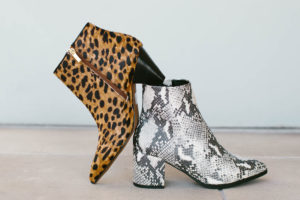Walk the Red Carpet of Fashion PR: NYC and Stilettos not Required
Published on May 23, 2022, at 9:40 a.m.
by Ivey Paulsen, Guest Contributor.
Public relations in the fashion world requires strutting down New York hallways in knee-high leather boots, tackling social crises and stabbing people in the back with stilettos — figuratively, of course. At least, that’s what the iconic film “The Devil Wears Prada” teaches us.
However, fashion PR does not have to be done in the shadow of the Empire State Building. What’s more, neither knee-high leather boots nor back-breaking stilettos are necessary to being successful in this field.
With the rise of boutique fashion and small-scale brand names, the fashion industry needs PR professionals in every city. It may look different, but PR is just as needed for a locally owned boutique as it is for Gucci and Louis Vuitton. In fact, boutique fashion may be the best place for aspiring fashion PR professionals to start.
Interviews with Gretchen Paulsen, who works on the social media team for the growing brand James Street Co., and Kayla Morris, the brand content specialist at Hope Ave., provided insight on practicing fashion PR in the smaller-brand division. They detailed their respective experiences and gave suggestions for students aiming to root their public relations careers in fashion.
Leopard print heels: A bold, creative and personal decision

In a fashion agency or in a corporate position for a far-reaching and well-established brand, there are entire teams working together to produce the organization’s public relations. Filling one of these positions requires multiple checkpoints, going through other people and extensive collaboration.
Morris said that her favorite thing about working on a local scale with a smaller brand is having complete creative control. There is a never-ending list of things to do and learn, so she never gets bored working through the same tasks and processes.
Morris appreciates the opportunity of trial and error that comes with working in local fashion. There is always room to grow with a smaller brand, and, as Morris said, “there’s less red tape.” She loves seeing her voice shine through in the brand and watching her ideas take flight and contribute to branding. This experience of exclusive personal creativity is unique to this sector of the fashion industry.
With creative control, recently graduated students entering the public relations field can exercise and build on all the skills that they learned in school, rather than having to focus on always fulfilling one specific niche or task. This liberty allows them to build their repertoire and find what areas of public relations interest them the most, without having to work around other people.

Black and white converse: A classic commonality among all wardrobes
A small or local brand offers something that may be missing in a brand that spans worldwide, or even just across the country — community. Paulsen said that the main difference she sees in high fashion versus boutique fashion is the connection between the brand and the consumer. Working on a smaller scale, she personally engages more with her audience. This engagement creates a sense of belonging between the brand and the consumer, and it also creates authenticity.
Paulsen noted that authenticity is vital in the boutique fashion field because it is obvious. When it is missing, there is a clear gap. When it is present, the strength of the brand is distinctly elevated, she said.
While a small brand encourages community among its customers, an air of competition exists between boutiques. Morris said that she follows other local boutiques on her personal account to see what her competitors are doing because the company she works for, Hope Ave., is blocked from seeing the pages of similar companies. Out of competition, all boutique brands have each other blocked on all social media platforms.
According to Morris, the brands are especially competitive with models. They are in a constant race to get the best models, and don’t want their models to be picked up by other stores. If a professional craves the drama of the red carpet, it can still be found in a boutique fashion career.
Building and maintaining a community is a valuable opportunity for recent PR graduates. They can practice personally communicating with and understanding their publics. Doing so will prove beneficial if they decide to move to a bigger, more public brand, as they will have experience creating trust and managing customer relationships.
Doc Marten boots: A must-have closet staple

Both fashion experts offered suggestions for students interested in building their careers in the boutique fashion industry. Due to the ever-changing nature of social media, Morris said that continuously learning is essential to survival in this field. She recommended getting as many certifications and completing as many training sessions as possible before beginning a job in boutique fashion, and then continuing to do those things to stay up to date.
When asked what practices are most useful in boutique fashion, both professionals mentioned staying on top of trends and following brands one aspires to be like. Paulsen said that she uses Pinterest frequently to get ideas and to find inspiration. Both Paulsen and Morris recommended getting familiar with social planning apps, such as Later and Planoly.
While anyone can be successful in this field with dedication and persistence, Morris said that an eye for style is crucial. Even if a person doesn’t feel established in their own style, it is essential to know how to put together an outfit. A passion for fashion makes this job exciting and rewarding.
At the end of “The Devil Wears Prada,” Anne Hathaway’s character becomes overwhelmed by the New York fashion scene and decides to work for a local newspaper. If a person finds the culture, glitz and glam of runway fashion to be daunting, especially right out of college, boutique fashion might be the perfect solution.
Working for a smaller scale brand allows a newly graduated PR student, who dreams of taking the world by storm in a pair of Jimmy Choo’s, to develop skills under their own creative control. Local fashion encourages community, connection and engagement, something that isn’t typically seen in high fashion. As noted by Morris and Paulsen, starting a career in boutique fashion will help new professionals develop and solidify skills in a local environment, which may be a catalyst for success in bigger brands.
Walking the red carpet doesn’t have to be a New York exclusive because it paves the streets of our local communities. As a bonus, stilettos are not required.




